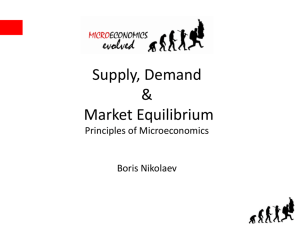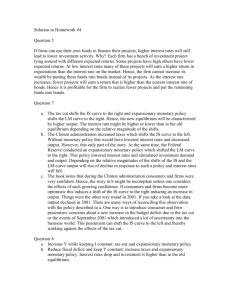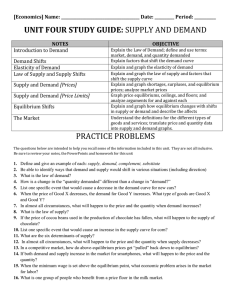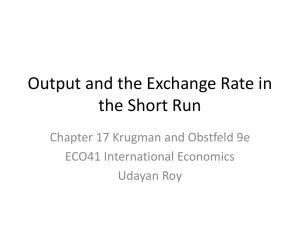Chapter 7
advertisement
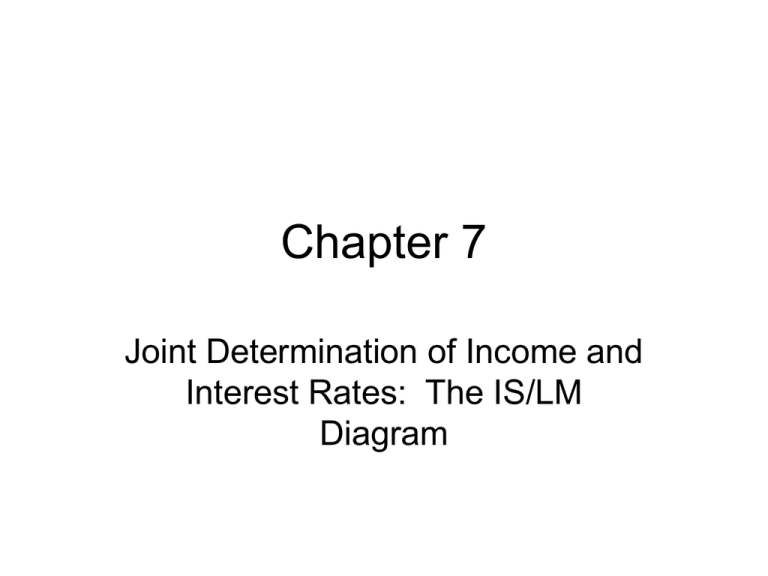
Chapter 7 Joint Determination of Income and Interest Rates: The IS/LM Diagram The IS/LM Diagram • When the economy is in a prolonged slump, the standard remedy is to use stimulative fiscal and monetary policy. However, that might not work for several reasons. • An increased demand for funds could boost interest rates. • Inflationary expectations might rise, boosting interest rates even if funds remained plentiful. • Expectations, especially in the stock market and for capital spending, might decline as the deficit increased. • An increase in demand might be partially or even totally offset by a rise in imports. The IS/LM Diagram (Slide 2) • Current economic theory and analysis takes all these factors into consideration. • The original IS/LM diagram only considers the first of these factors – the possible rise in interest rates. Other factors will be added after the chapters on inflation and foreign trade are presented. • Even this simple case, however, accurately portrays the interrelationship between output and interest rates. Demand cannot be expanded indefinitely without taking into account the impact on financial markets. The IS/LM Diagram (Slide 3) • This diagram consists of two curves. The IS curve represents all the points of equilibrium in the goods market, and indicates the level of aggregate demand that would occur for each level of interest rates. • The LM curve represents equilibrium in the assets market, and indicates the level of interest rates (and credit availability) that would occur for each level of aggregate demand. • The intersection of these two curves jointly determines output and interest rates. Equilibrium in the Goods Market • Saving must equal investment ex post. That is an accounting identity, and is the same thing as saying GDP must equal gross national income. But what does that mean in an economic sense? • Suppose there is a negative exogenous shock in the economy, so consumers decide to save more but businesses decide to invest less. Yet we know that on an ex ante basis, the changes must be the same. How is the difference reconciled? How I = S ex post • Sometimes interest rates will decline, hence reducing consumer saving and boosting investment. • To a certain extent, weakened business conditions mean government and foreign saving will decline. • But often, these are not sufficient to reach equilibrium. We must also take into account the change in income that influences saving. • In particular, a drop in income reduces all four components of saving. • If lower interest rates and fiscal stimulus do not achieve equilibrium, then income must fall until saving is reduced enough to offset the initial planned increase. The IS Curve • At each level of income, I must equal S on an ex post basis. At high interest rates, I and S will both be low. I will be low because of the negative impact of high interest rates, and S will be low because of the low level of income caused by reduced investment. As interest rates decline, both I and S will increase. Thus the relationship between all the equilibrium points where I = S and the rate of interest will have a negative slope. That line is known as the IS curve. Shifts in the IS Curve • A change in interest rates will cause a movement along the curve, but it does not shift. • Any exogenous change in the components of aggregate demand will cause the curve to shift. • Change in fiscal policy: government purchases or tax rates • Change in value of the currency of growth in income in foreign countries • Change in monetary policy • Change in consumer or business attitudes • Rate of growth in technology Equilibrium in the Assets Market • Of course everyone would like more money rather than less. The “demand for money” does not refer to this phenomenon, but to asset allocation between money and bonds, which in this case represents assets whose market value fluctuates. While there are many other types of assets, only these two classes are used here. Equilibrium in the Assets Market, Slide 2 • For any given level of income, consumers will allocate their assets between money and bonds. As income rises, they will hold more money for transactions purposes. More important, as interest rates rise, they will hold more of their assets in bonds. That means there will be less money available for loans, which will reduce the availability of credit and hence GDP. The LM Curve • The LM curve represents all the points of equilibrium in the assets market. It shows the allocation between money and bonds at each different level of income and interest rates. • As income rises, the demand for money will also rise, which means for a given money supply, fewer assets are available to be invested in bonds, hence boosting interest rates. • Thus higher levels of income are associated with higher levels of interest rates in the assets market, and the LM curve has an upward slope. The IS/LM diagram • The intersection of the IS and LM curves jointly determine interest rates and income. • If an exogenous increase in income occurs, the IS curve moves out. However, that means interest rates will rise. Thus some of the initial increase in demand is offset by higher interest rates. IS/LM Diagram, Slide 2 • If it desired, the central bank could ease monetary policy and move the LM curve out when the IS curve moves out, thereby holding interest rates constant. During periods of economic slack and stable inflationary expectations, that would boost the level of income substantially. The risk is that by raising inflationary expectations, interest rates would rise in spite of central bank accommodation. IS/LM Diagram, Slide 3 • Inflation is not included in this simple diagram, yet the lesson is well worth learning. Fiscal expansion is no “free lunch”; if carried to excess, it will generate a negative reaction in financial markets, and the initial gains will be offset. • If that were not the case, all countries could remain at full employment all the time simply by having the government spend more and more. Of course that is nonsense. So in spite of its limitation of holding inflation constant, the IS/LM diagram illustrates this important relationship. Asymmetries in the IS/LM Diagram • During periods of economic slack • Cutbacks in government spending have a larger negative impact than the positive impact from a rise in spending • Monetary easing has only a modest expansionary effect, but further tightening would have a much larger contractionary effect • Tax increases have a larger negative impact than the positive impact of tax cuts. Asymmetries in the IS/LM Diagram, Slide 2 • During periods of full or overfull employment: • Monetary easing is more likely to boost inflation than real growth, while monetary tightening will have a much greater effect • A rise in government spending will boost inflation rather than real growth, while a cutback in spending will have little negative impact • The case for a change in tax rates is more complicated because it depends on whether it is temporary or permanent. In general, a temporary tax increase would be ignored, while a permanent tax increase would reduce real growth but might also raise inflation because taxes are a cost that has increased. The IS/LM diagram does not provide a complete answer in this case. Factors That Shift the IS and LM Curves • • • • • • • • • • Increase in fiscal stimulus (rise in government spending or tax cut) Increase in value of the dollar Increase in inflationary expectations Drop in propensity for personal saving Exogenous rise in stock market Change in sentiment boosts investment Change in tax rates that reduces the cost of capital shifts out shifts in shifts in shifts out variable shifts in shifts out neutral* shifts out neutral* shifts out neutral* shifts out prices -- shifts out deficit – shifts in • Exogenous boost in productivity shifts out IS curve LM curve shifts out * Movement along the LM curve, assuming no exogenous change in monetary policy Summary • The IS/LM curve is a very useful first step in showing the joint determination of output and interest rates, and explaining how continued increases in fiscal policy will not necessarily boost output. • Its major drawback is that it assumes inflation, and inflationary expectations, remain constant. That is not the case when fiscal and monetary policy are overly accommodative, so the model is modified to take these into consideration.


